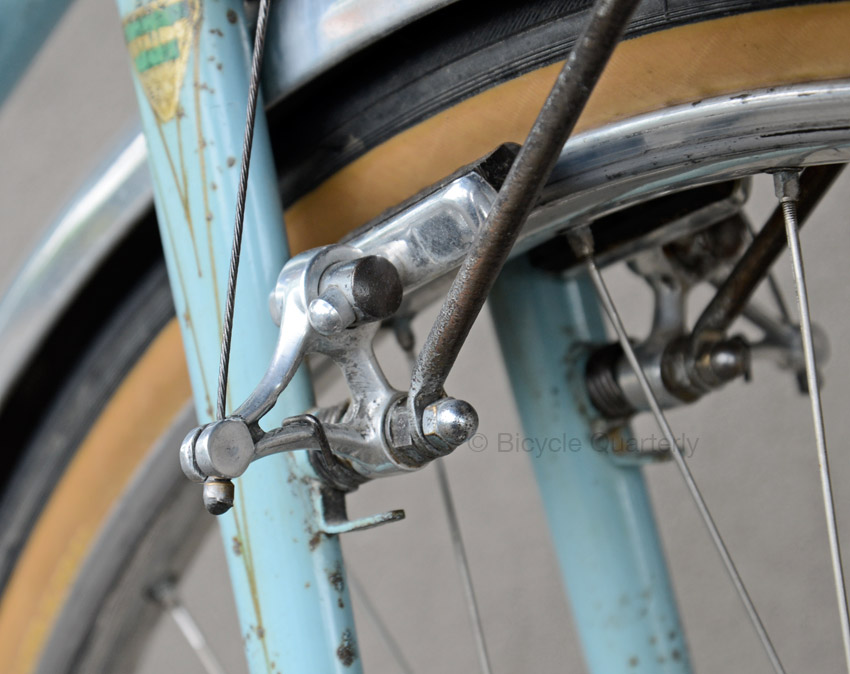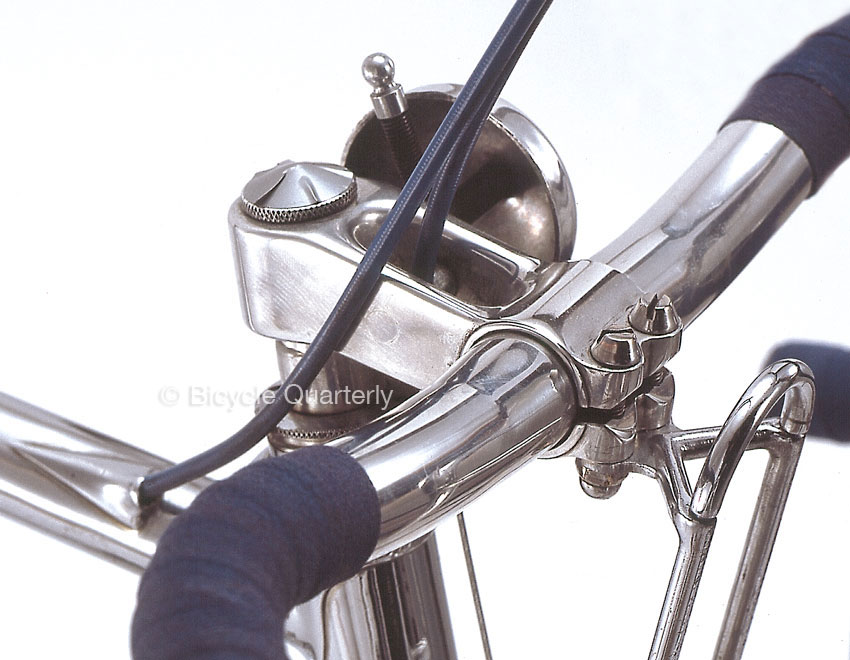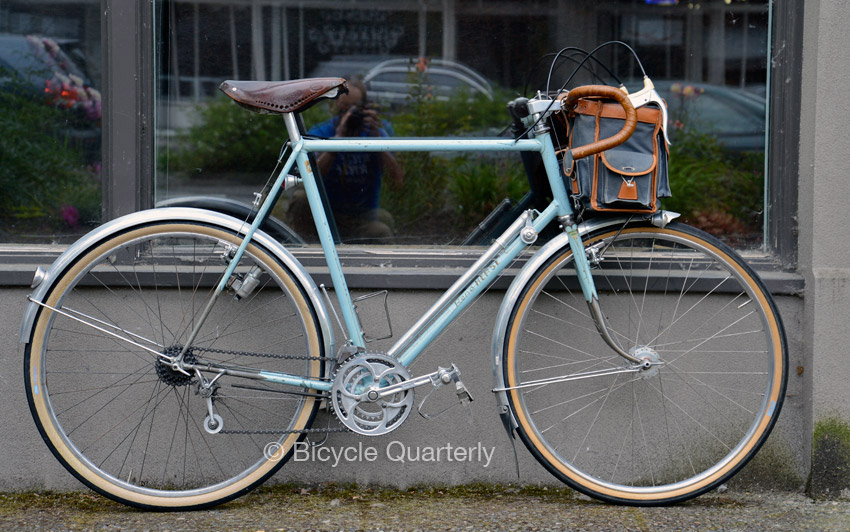Supporting the Classics

When we became custodians of the René Herse name, we had three goals in mind:
- Bring back some of the best designs of René Herse, so that today’s cyclists could enjoy their excellent function and aesthetic.
- Support classic René Herse bikes with components, so that they can be kept on the road, or get restored correctly.
- Protect the René Herse trademark.

We like these bikes so much, and we couldn’t stand the thought that someone might exploit the name, logo and designs without respect for the heritage – with only an 80-year-old lady trying to protect her family’s life work. So we suggested to Lyli Desbois, née Herse, that she sell the rights to the name, designs, tool, etc., to somebody who could take over the custodianship of the René Herse name and heritage.*

A big step happened a few weeks ago, when our registration of the René Herse trademark was approved by the U.S. Patent Office. While the trademark and designs were protected as soon as we bought the company from Lyli Desbois and started using them again, now nobody can claim that they didn’t know the trademarks were protected. There is no risk of the René Herse logo showing up on budget frames or cheap knock-off components.

These legalities aside, we also have made progress on the other points. Our René Herse cranks have proven themselves, and many riders are enjoying not just their beauty and light weight, but also their almost unlimited chainring choices.
And owners of classic René Herses can get chainrings again for their bikes, at least for the ones made after the mid-1960s.
Now we are proud to introduce a few additional parts for classic René Herses and other cyclotouring bikes.

Early René Herse’s bike were equipped with cantilever brakes of his own design. The brake pad holders were one-piece castings, which were designed for then-common short brake pads. The short pads cleared the fork blades and chainstays when the brake was opened to remove a wheel – a nice feature.
Decades later, the short brake pads had become obsolete. When the brake pads of René Herse bikes wore out, many riders fitted Mafac pads. These pads were longer and didn’t fit in the original holders, so riders installed Mafac holders as well – as on the bike shown above. As a result, the original Herse pad holders are very rare today. And the longer Mafac pads scratch the paint every time you remove a wheel…

We now offering replacement Herse brake pad holders. We made them a bit longer than the originals, so they fits Kool-Stop’s excellent Mafac reproduction brake pads. (Unfortunately, making replicas of the original pads is too expensive at this point.) To clear the fork blades, we offset the pad slightly from the mounting post. You don’t notice it, but it provides just enough clearance to open the brake all the way. The pad holders have the same angular aesthetic of the Herse originals, and they are also cast as one-piece units for durability.

Many Herse bikes lost their wonderful straddle cable holders over the decades. We now offer replicas that allow you to complete your restoration. Of course, you also can use them on any other bike that has centerpull or cantilever brakes.

Mafac’s centerpull brakes are found not just on René Herse’s bikes, but on many other classic and modern bikes. Their performance is without par, but unless you find a set of “New Old Stock” (NOS) brakes, they’ll have seen decades of hard use. Fortunately, the arms don’t wear out, and we now offer all the other parts you need to make a set of Mafac brakes better than new. If your brakes are equipped with plastic bushings that have developed play, you can use our brass bushings to restore the performance of your brakes. (We’ll offer a tool to press in the bushings soon.) Or you can get a complete overhaul kit that replaces every nut and bolt on your brakes.

Kool-Stop now makes replicas of Mafac’s “four-dot” and “five-dot” brake pads, but with modern rubber. They are available in black and with Kool-Stop’s excellent “salmon-colored” compound (above) that offers superior braking in wet and dry conditions. We have these in stock, too.

One of the things that makes René Herse bikes special are the custom-made screws and bolts. This practice came from his aircraft background: During the early 1900s, there were no standards for bolts. Aircraft makers made their own screws to ensure they were strong enough. A bolt failure on an aircraft can have devastating consequences! The aircraft builders designed their own head shapes, so mechanics in the field could immediately see if a bolt had been replaced by a generic one of potentially inferior quality.

Drawing on that tradition, Herse made his own bolts, too. The triangular heads for his M6 seatpost binder and stem bolts are truly iconic. We now offer replicas.

We also offer the smaller M5 screws with their distinctive round heads, which Herse used to attach racks and waterbottle cages. These screws feature rolled threads, super-strong CrMo construction and durable chrome-plating. They are great not just for restorations, but also for modern bikes where you want screws that look nicer and are stronger than generic stainless steel screws.

Herse also made special bolts to attach his brakes. The rear one features a built-in washer and a much sturdier head than the thin Mafac bolts that tend to break. The front bolts (above) were even more ingenious, as they incorporated a forward extension to attach a rack.
In recent years, these bolts have been imitated by many, but never equaled. The originals incorporated a washer, and the forward extension was smaller in diameter, because the rack pushes down on the bolt and so doesn’t need as much clamping force. We now offer replicas that match the originals 100%.

Many 1940s bikes from the best French constructeurs used fender eyebolts with round heads. They are so much more elegant than the large angular heads on current eyebolts. When I restored the PBP-winning Herse tandem, one of the more tedious jobs was making the classic eyebolts and matching cups – 9 sets. (Eight for the fenders, the ninth holds the battery-powered taillight to a fender stay.) Now we offer these eyebolts in two lengths: 7 mm (stay to fender connection) and 11 mm (stay to dropout connection).

Maxi-Car hubs are my favorite hubs. With double labyrinth seals, they spin smoothly for decades. Unfortunately, they haven’t been made in 15 years, and when you find a used one, it often doesn’t have the axle length you need. To help with this situation, we offer reproduction Maxi-Car rear axles in two versions: One drilled for quick releases (left) and 140 mm long, so it can be adapted to all rear hub spacings from 115 to 130 mm.
The second version is for a Nivex-style chainrest (right). It features a stub end that is drilled to receive the wing screw that holds it to the right dropout. The stub end ensures that the axle doesn’t extend beyond the outer edge of the freewheel, so the wheel clears the chain as it is removed.
Both axles are machined from CrMo steel and heat treated, so they are even stronger than the originals.

Our final product is potentially the most useful: We asked Gilles Berthoud to re-make the Sologne panniers in a classic model. Unlike Berthoud’s contemporary version with its plastic Klick-Fix attachment that tends to rattle, the classic panniers attach with leather straps and metal springs. This provides a relatively theft-proof and secure attachment that works on (almost) any rack, provided it has a spot where the hook at the bottom can attach.
I use these panniers for all my touring, since they are waterproof and the laces allow expanding or contracting them as my luggage needs require. I have one original set that was made in 1974, yet still is going strong. Quantities are very limited, since these are specially made by Gilles Berthoud in France for us.

We hope to expand these offerings in the future. Some high-end car makers like Porsche and Mercedes-Benz offer parts and support for the classics they made decades ago. We strive to provide the same service for the wonderful bicycles of René Herse.
Click on here for more information about our classic parts.
* In 2007, I negotiated the purchase for Boulder Bicycles, who bought the name from Lyli Herse. In 2011, Compass Bicycles Ltd. bought the trademark from Boulder Bicycles.


